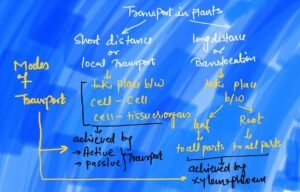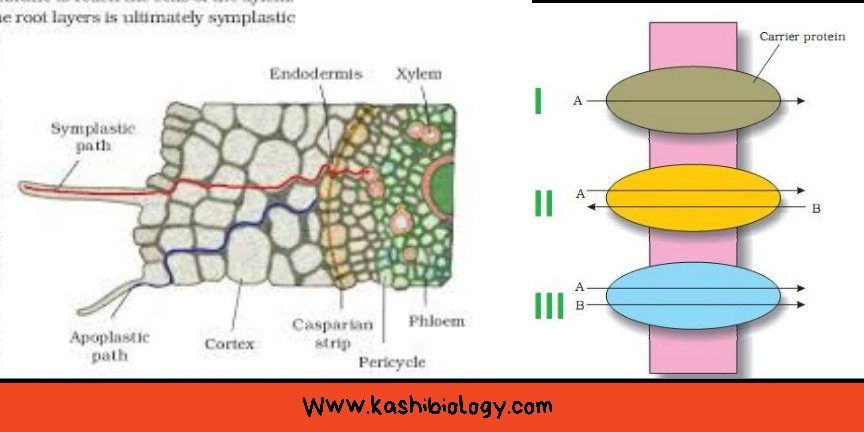Hello welcome to kashibiology. We have almost completed most of the topics on Human Biology on our website ,today we are going to discuss about topics of Plant biology. Plant transport happen with the help of two types tissues i.e Xylem and Phloem . So lets get into this topic and find out more details .
Transport mechanism in Plants
Plants have complex trafficking of compounds but in a very orderly manner.
The transport in the plant involves all the types of essential chemicals which are necessary for the survival and overall growth of plants.
Plants follow different strategies for the movement of essential chemicals inside the body as well as from outer environment to inside of the body.
The strategies of the movement of most of the Organic chemicals directly related to the distance between one cell to others or one organ to others.
What are the transportable substances in plants?
Plants need water, minerals, organic photosynthates(glucose), gases and hormones etc.
These are transported in all body parts of the plant body.
All these chemicals are essential to carry out the overall metabolic process in an orderly manner.
For example-
Water-
Water needed for the metabolic is used as a medium for metabolic reactions as well as in photosynthetic process as a source of Oxygen and hydrogen ions and electrons which are later used in assimilatory(ATP, NADPH) power generation.
Mineral ions-
Mineral ions are also used in the metabolic processes.
Many ions are act as inhibitors or activator of enzymes (like Mn-manganese is the activator of Enzyme hexokinase)
Hormones-
such as-Auxin, Gibberellin, Abscisic acid, Cytokinin and Ethylene etc. regulate overall growth and reproduction in plants.
Organic photosynthates-
such as-Glucose used in the energy source and catabolism in aerobic respiration.
Nitrogen containing organic molecules-
such as amino acids, proteins, nucleic acids and enzymes also play a major role in growth and development of plants at cellular level.
Amino acids-
These are the monomeric units of proteins.
Proteins-
Most of the regulate all the physiological functions in the plant body.
Enzymes-
They regulate all the metabolic reactions and act as biocatalysts in biochemical reactions.
Nucleic acid-
DNA is the genetic material. RNA involved in protein metabolism and splicing process.
Carbon Dioxide-
It is used in the dark reaction of photosynthesis and reduce into carbohydrates or glucose.
How are these chemicals transported in plants?
Plants show two types of transport mechanism on the basis of distance between source to sink.
1- distance transport or local transport
2- long distance transport or translocation
Besides this the export and reexport of the chemical molecules also take place within the plant body.
Such as some time the storage organ in the plant body becomes the source organ and the growing organ or structure becomes sink.
It also depends on the season. In autumn leaves are shedding, hence photosynthesis activity is very less.
Therefore growing structure needs organic photosynthates like Glucose, which is supplied by Storage organ.
What is short distance transport?
The transport of organic chemicals between Cell to cell, or cell to nearby tissues or within the cell is called short distance transport.
For local transport it generally involves movement of molecules from one cell to adjacent cells or nearby cells.
Modes of short distance transport-
Short distance transport take place by-
- Active transport
- Simple diffusion
- Facilitated diffusion
- Osmosis
- Cytoplasmic streaming
Cytoplasmic streaming is the movement of cytoplasm within the cell which helps in the equal distribution of all the important chemicals within the cell and cell organelles.
What is long distance transport?
The long distance transport of chemicals in the plants involves movement of photosynthetic organic chemicals from leaves to all parts of the plant body.
Similarly the movement of water and minerals ions from the soil to root and from root to all parts of the plant body is also the long distance transport.
Such a long distance transport system of molecules is called translocation.
How long distance transport takes place in a plant?
In the case of plants long distance transport takes place by specialised vascular tissues also called conducting systems.
These vascular tissues are two types namely xylem and phloem.
Xylem transports the water and mineral ions from the root to all parts of the plant.
Whereas, Phloem transport organic photosynthates from leaves to all parts of the plants.
How gases are transported in plants?
In plants tiny pores are present in the lower surface of leaves called stomata.
Stomata are the means of gaseous exchange. When the stomata open the exchange of carbon dioxide and oxygen take place.
Some other openings are also present in the plant body. such as Bark and Lenticels.
These structures also help in the gaseous exchange but to a very little extent.
Most of the gaseous exchange takes place by the stomatal pore.

What is the concept of Source and Sink in a plant transport system?
Source is any part or structure of the plant body that synthesized organic chemicals.
such as mesophyll cells in the leaves are the site of photosynthesis.
that is it is the source structure for Organic chemicals like glucose(type of carbohydrates)
Similarly Sink is the structure which used to store the organic food or growing structure which immediately used organic food as source of energy.
Storage areas in the plant body are those structures, which Store synthesis of organic chemicals or carbohydrates.
The storage organ may be root or stem. hence act as Sink.
Growing structures in the plant body like growing Leaf buds, flower buds etc. are immediately used carbohydrate for energy source also known as the Sink.
Conclusion
As other organisms like humans & animals, plants also have a specific system for transport of chemicals within the body.
Thanks for reading this post.
have a good online journey.

